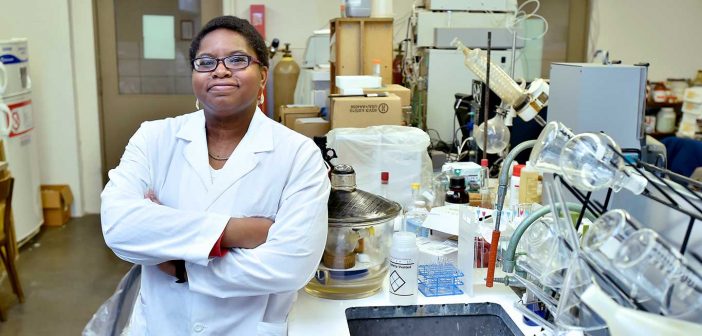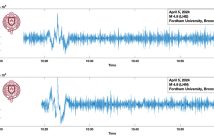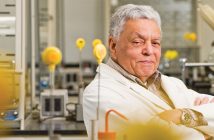Marie Thomas, PhD, is on a quest for the perfect liquid.
It has to be easy to make and easy to refine. It should be benign when released into the environment. And most importantly, it needs to break down cellulose just right.
Thomas, an assistant professor of chemistry who joined the Fordham faculty in 2014, specializes in the study of ionic liquids— salts that take the form of liquid at room temperature. They are sometimes called “designer solvents”. These types of liquids can be used to break down cellulose, which is widely found in all plants. (Ethanol, a corn-derived fuel added to gasoline in the United States, is derived from a similar process.)
“The idea is, if we can work to dissolve [cellulose]better, then maybe we can eventually switch over to use more complicated materials, such as waste plant materials like paper or saw dust, in making fuel,” she said.
In the multistep process of converting cellulose into biofuel, Thomas’ work sits right at the very beginning process. She said the focus on ionic liquids is driven by a desire to both find an alternative to toxic and corrosive chemicals that are currently being used in fuel conversion and to expand the fuel source material beyond corn—a food substance.
Since the 2005 passage of the Renewable Fuel Standard, which mandates that oil refiners blend ethanol into gasoline, the price of corn has more than doubled—from an average of $1.96 per bushel in 2005 to an average of $4.11 per bushel in 2014. Corn is the main food source for cattle, so increased demand for it also drives up the prices of meat.
“We want to get away from that problem by using different plants, like straw, for fuel,” she said. “Even if we continue to use corn, we want to use the waste material of corn to make ethanol instead of our food sources,” she said. “That might relieve the tension between food versus fuel that’s going on.”
Thomas first became familiar with the potential of ionic liquids for dissolving cellulosic materials during a postdoctoral research assignment at the Brookhaven National Laboratory (BNL), where, as an organic chemist working among physicists and physical chemists, she joked she was the “odd one out.” Some of the results of that research, published in the paper “Probing the Physical Properties, Synthesis and Cellulose Dissolution Ability of Dialkyl Phosphate Ionic Liquids” (Phosphorus, Sulfur, and Silicon, 2015. The work done at BNL introduced her to ionic liquids’ possibilities.
And those possibilities are nearly infinite, she said. By choosing a specific cation, (an ion with net positive charge i.e., having more protons than electrons) and an anion, (an ion with a net positive charge, i.e., having more electrons than protons), scientists can create an ionic liquid or salt that has the kind of thermal stability, range, and conductivity ideal for breaking down any kind of cellulose.
It has been estimated that there are 7 million possible variations of ionic liquids, although only a few thousand have been made and even fewer are used on a regular basis, she said. Many are considered environmentally friendlier than most presently used solvents, due to their low vapor pressure and the possibility that they can be recycled.
The challenge, however, lies in not so much the creation of ionic liquids as in the purification process, said Thomas.
“We prefer our organic compounds to be as color-free as possible, because it’s one indication of purity,” she said. “A lot of times, you make these things and they come through with color.”
“We don’t always know what the impurities are, but we try to get rid of the color/impurities anyway, and get the liquids clean,” she said.
For a future project, Thomas said she’s interested in looking into the potential uses of ionic liquids in the pharmaceutical industry. One way would be to offer more drugs in liquid form for better absorbability and efficacy. Another would be to combine complementary pharmaceuticals.
“A new drug perhaps has two functions. Say you combine an antibacterial that’s a cation with a painkiller that is an anion. If it’s a liquid, you’ve developed a drug (which happens to be an ionic liquid), that has antibacterial and pain killing properties,” she said. “This opens up new avenues of drug delivery.”



